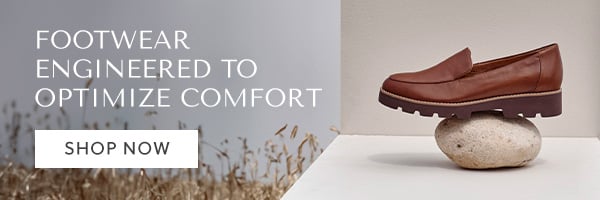
Whether you’re an athlete, a parent chasing after their little ones, or someone who enjoys a leisurely stroll around the neighborhood, taking care of your knees is optimal to ensure you remain active and pain-free. That’s why understanding the causes of knee pain is crucial for helping you manage and prevent discomfort.
So, what causes knee pain, and, more importantly, what steps can you take to avoid it altogether?
In this guide, we’ll break down the common causes of knee pain from arthritis to muscle imbalances, explore how factors like posture and overuse can impact your knees, and review the importance of proper footwear when caring for your joints.
Common Causes of Knee Pain
Knee pain can arise from a variety of sources, including injuries, medical conditions, and lifestyle factors. Here’s a look at some of the most common causes of knee pain.
Arthritis: The Silent Culprit Behind Knee Pain
Arthritis is often referred to as the “silent culprit” behind knee pain, particularly in older adults. It is a degenerative joint disease that can significantly impact mobility and quality of life. Here’s a closer look at the types of arthritis that commonly affect the knees:
- Osteoarthritis – Osteoarthritis is the most common form of arthritis, characterized by the wear and tear of cartilage over time. As the cartilage breaks down, bones may rub against each other, which can cause pain, swelling, and stiffness.
- Rheumatoid arthritis – This is an autoimmune disorder where the body’s immune system attacks the joint lining, leading to inflammation and pain. Unlike osteoarthritis, rheumatoid arthritis can affect people at any age and often involves both knees
- Post-traumatic arthritis – This type of arthritis can develop after a trauma, like an injury, happens to the knee, including fractures and ligament tears. Even after your injury has healed, the joint may become arthritic because of changes in the joint structure.
Fortunately, regular low-impact exercise like walking or gentle cycling can help maintain joint function and reduce stiffness, so you can still enjoy the hobbies you love most.
Sprains, Tears, and Fractures Impacting Your Knees
If you’re worried that an injury may be the culprit behind your newfound knee pain, you’ll want to determine whether it’s a sprain, tear, or fracture:
- Sprains – A sprain occurs when the ligaments that connect bones in the knee are stretched or torn. This can happen during sports or physical activities that involve sudden movements or changes in direction.
- Tears – The knee contains several important structures, including the meniscus (a C-shaped piece of cartilage found in each knee) and ligaments (ACL, PCL, MCL, LCL). Tears in these structures can lead to significant pain and knee instability. For example, an ACL tear is a common injury among athletes and usually requires surgery to ensure full recovery.
- Fractures – A fracture in any of the bones that make up the knee joint can cause pain and swelling. This type of injury often results from falls or high-impact sports. They usually require immediate medical attention, so it’s important to act quickly if you think you may have fractured a joint in your knee.
Whether you’ve injured your knee on impact or you notice that pain is gradually increasing over time, it’s important to visit a physician or physiotherapist if you think you may have a sprain, tear, or fracture.
Muscle Imbalances: A Hidden Cause of Knee Discomfort
If you’ve ruled out factors like arthritis, strains, and fractures and are still wondering what causes sudden knee pain without injury, you may be dealing with a muscle imbalance, which is a commonly overlooked cause of knee pain.
Imbalances happen when certain muscles are stronger or tighter than their opposing muscles, which can lead to improper alignment and function of the knee joint. Here’s a look at some muscle imbalances that typically affect the knees:
- Quadriceps and hamstrings – Your quadriceps (front thigh muscles) and hamstrings (back thigh muscles) work together to stabilize your knees, so if one group is significantly stronger than the other, it can lead to knee pain and dysfunction. That’s why it’s important to maintain the balance of strength and flexibility among these muscles.
- Hip muscles – Weakness in the hip muscles can also lead to increased stress on the knee joint. Exercises and stretches that strengthen the hip abductors (like your gluteus medius and gluteus minimus) and external rotators can help improve knee alignment and reduce pain.
- Calf muscles – Tight calf muscles can restrict ankle mobility, which can affect knee function. Fortunately, stretching and strengthening the calves can help alleviate knee discomfort.
With targeted exercises and physical therapy support, muscle imbalances are typically treatable, making it easier for you to minimize knee pain without the need for serious treatment or surgery.
How Poor Posture and Alignment Contribute to Knee Pain
Poor posture and alignment can place excessive stress on the knees, leading to discomfort and pain. Common postural issues that can affect the knees include:
- Knock-knees – This condition, also called genu valgum, occurs when the knees angle inward, causing the lower legs to bow outward. It can lead to increased stress on the knee joint and contribute to pain.
- Bow legs – In contrast to knock-knees, bow legs, or genu varum, occur when the knees are positioned outward. This can also lead to uneven wear on the knee joint and discomfort.
- Flat feet – You might wonder, can flat feet cause knee pain? Absolutely. Flat feet can affect the alignment of the entire lower body, leading to knee pain. Fortunately, footwear that offers proper arch support and orthotics can help alleviate pain in the feet and knees.
Improving posture through exercises that strengthen the core and promote proper alignment can help reduce knee pain.
The Impact of Overuse and Repetitive Strain
While they’re good for your overall health, repetitive physical activities like running, cycling, and jumping can all lead to overuse of your knee joints and repetitive strain. While this doesn’t mean you need to stop your active lifestyle altogether, here are some overuse injuries to look for if you notice you’re experiencing knee pain regularly:
- Patellar tendinitis – Also called jumper’s knee, this condition occurs due to inflammation of the patellar tendon, often seen in athletes who participate in jumping sports. Symptoms include pain at the front of the knee, especially during activity.
- Iliotibial band syndrome – This condition occurs when the iliotibial band (a thick band of tissue running along the outside of the thigh) becomes tight and inflamed, causing pain on the outer side of the knee. Iliotibial band syndrome can cause sharp pain on the outside of your knee or hip.
- Bursitis – Inflammation of the bursae (small fluid-filled sacs that cushion the knee joint) can occur due to repetitive motion or prolonged pressure on the knee.
- Runner’s Knee – Also known as patellofemoral pain syndrome, runner’s knee is characterized by pain around the kneecap, especially when bending the knee or going up and down stairs. It often results from repetitive strain on the knee joint, particularly in runners, cyclists, and those who engage in activities that involve frequent knee bending. Focusing on proper runner’s knee recovery is essential to prevent further injury and manage the discomfort effectively.
To prevent overuse injuries, it’s essential to incorporate rest days into your exercise routine, vary your activities, and listen to your body.
Understanding Wear and Tear Over Time on Knees
If you’re not an avid athlete and are careful not to overexert your muscles, you may still be wondering what causes knee pain and swelling. The answer might be simpler than you think: wear and tear.
Over time, our bodies undergo natural wear and tear, and the knees are no exception. The cartilage that cushions the knee joint can gradually wear away. Several factors can contribute to wear and tear, including age and previous injuries.
For example, the risk of developing knee pain increases with age as the cartilage becomes less resilient, while past injuries can lead to changes in knee mechanics, increasing the likelihood of developing arthritis or other degenerative conditions. Maintaining a healthy lifestyle, including regular exercise and a balanced diet, can help combat these effects and support strong, agile knees for years to come.
The Importance of Proper Footwear in Preventing Knee Pain
Whether you’re walking to work, strolling around the grocery store, or grabbing a cup of coffee, your knees are always in use. This means that even if you’re wearing proper footwear while running or cycling, it’s essential to find comfortable and supportive shoes for everyday wear, especially if you’re trying to treat or avoid knee pain.
Here are three factors to prioritize when you’re looking for the perfect footwear for preventing knee pain:
- Support – Shoes that provide adequate arch support can help maintain proper alignment of the lower body, reducing stress on the knees. Look for supportive and stylish options, like the Bella Toe Post Sandal or our sleek Uptown Loafer, to ensure you have adequate support whether you’re at the park, on the move, or in the office.
- Cushioning – Proper cushioning can absorb shock and reduce impact on the knees during activities like jogging or walking. Walking sneakers designed with your feet in mind like the 23Walk 2.0 Sneaker and the Walk Max Lace Up Sneaker offer lightweight cushioning so your knees have the balance of support and stability they need to support your active lifestyle.
- Fit – Shoes that fit well and are appropriate for your foot type can prevent discomfort and reduce the risk of injuries. Classic sneakers like the Winny Sneaker are available in both medium and wide fits to accommodate your unique needs and ensure you’re comfortable whenever you hit the pavement.
If you’re actively searching for the best shoes for knee pain, you’re in the right place. At Vionic, you’ll find that all of our styles include built-in orthotics, and varying widths and types of arch support to promote healthy alignment and reduce strain on the knees.
Give Your Knees the Support They Need with Vionic
Now that you understand what can cause knee pain, find shoes your joints will love (and styles that will love them right back) with Vionic. Whether you’re recovering from a knee injury or looking to support and strengthen your muscles to prevent future discomfort, we’ve got you covered.
For all things recovery-related you can count on the Tide RX Recovery Sandal, engineered with Vionic’s advanced recovery system (VRX) and dual-density cushioning to give your knees the relief they deserve. Looking to boost your knee support while on the job? The Willa Slip On Flat features a seamless silhouette with serious support—so you don’t have to sacrifice comfort for style.
No matter your knees’ needs, check out our footwear collection and find out how taking care of your knees today can lead to a more active tomorrow!
Sources:
Boston’s Children’s Hospital. What is knock knees? https://www.childrenshospital.org/conditions/knock-knees
Cleveland Clinic. Iliotibial Band Syndrome. https://my.clevelandclinic.org/health/diseases/21967-iliotibial-band-syndrome
Cleveland Clinic. Post-Traumatic Arthritis. https://my.clevelandclinic.org/health/diseases/14616-post-traumatic-arthritis
Cedars Sinai. The Healthy: Four Signs You Have a Muscle Imbalance. https://www.cedars-sinai.org/newsroom/the-healthy-four-signs-you-have-a-muscle-imbalance/
John Hopkins Medicine. Torn Meniscus. https://www.hopkinsmedicine.org/health/conditions-and-diseases/torn-meniscus
Mayo Clinic. Osteoarthritis. https://www.mayoclinic.org/diseases-conditions/osteoarthritis/symptoms-causes/syc-20351925
Mayo Clinic. Rheumatoid Arthritis. https://www.mayoclinic.org/diseases-conditions/rheumatoid-arthritis/symptoms-causes/syc-20353648
Mayo Clinic. Sprains. https://www.mayoclinic.org/diseases-conditions/sprains/symptoms-causes/syc-20377938
Mercy Health. Knee Fracture. https://www.mercy.com/health-care-services/orthopedics-sports-medicine-spine/specialties/knee-leg/conditions/knee-fractures
John Hopkins Medicine. Patellar Tendinitis. https://www.hopkinsmedicine.org/health/conditions-and-diseases/patellar-tendonitis-jumpers-knee


Leave a Reply